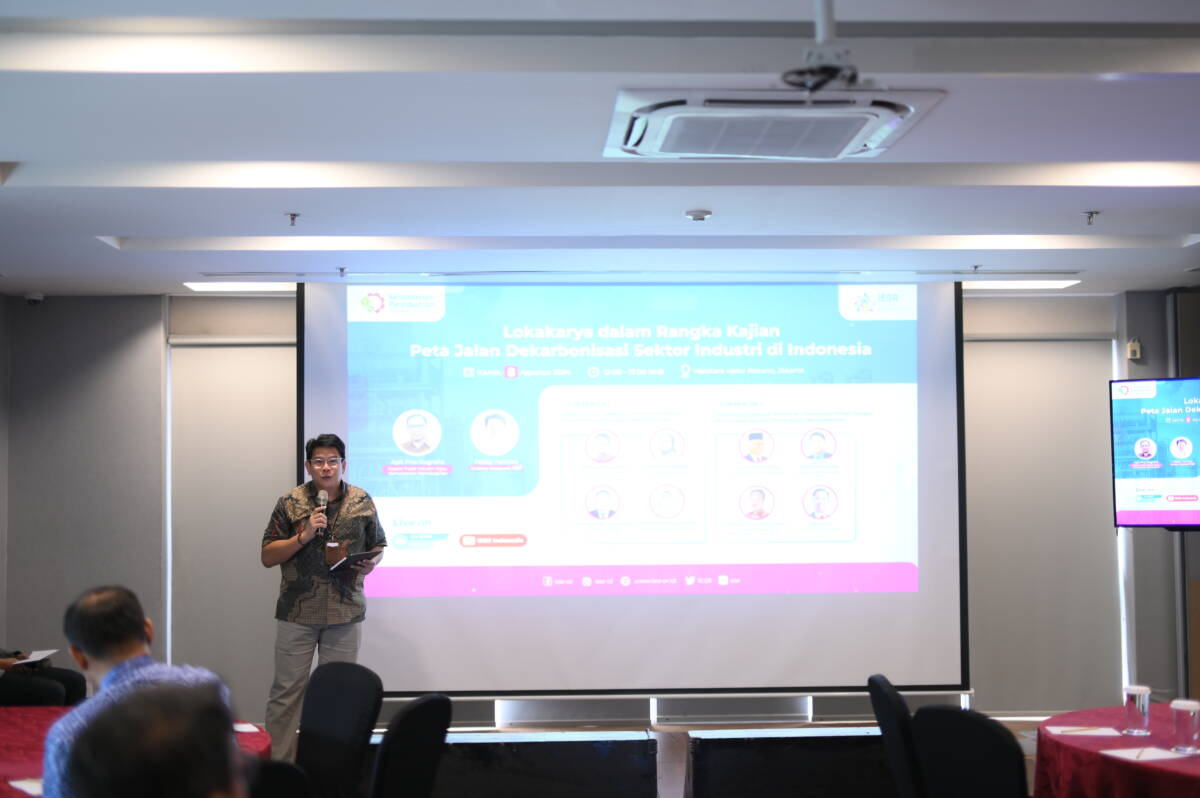
Jakarta, August 8, 2024 – Industrial sector emissions in Indonesia continued to increase in 2011-2022. In 2022, industrial sector emissions reached more than 400 million tons of carbon dioxide equivalent from energy use, production processes, feedstock use, and waste. The use of fossil energy to generate heat in industrial processes and electricity generation is the cause of the increase in greenhouse gas emissions. To significantly reduce emissions in the industrial sector, the Ministry of Industry encourages decarbonization action by designing a green industry roadmap to achieve a net zero emission (NZE) target by 2050.
The Institute for Essential Services Reform (IESR), in collaboration with the Ministry of Industry, held a workshop on Thursday (8/8/2024) to design a decarbonization roadmap study for the industrial sector in Indonesia. This activity is part of IESR’s preparation of a decarbonization roadmap for the textile, ceramics and glass, food and beverage, and transport equipment industry subsectors.
Apit Pria Nugraha, Head of the Green Industry Center, Ministry of Industry, explained that Indonesia’s industrial decarbonization roadmap will provide clear direction and policy guidance to encourage a more environmentally friendly and highly competitive industry. Emission reduction policies in the industrial sector need to be implemented to increase strong, inclusive, and sustainable social competitiveness from social, economic and environmental aspects.
“We are currently preparing strategic steps to support decarbonization in the industrial sector, including decarbonization roadmaps and regulations in the industrial sector and priority sub-sectors, carbon trading roadmaps for the industrial sector, carbon economic value governance for the industrial sector, regulations for the use of CCS/CCUS with a focus on carbon capture and utilization in the industrial sector, and an industrial sector carbon trading information system integrated with the national registry system (SRN),” said Apit.
Furthermore, Apit invited collaboration between the Ministry of Industry, the Ministry of Energy and Mineral Resources, and the Ministry of Environment and Forestry to integrate reporting and monitoring instruments while still accommodating each ministry’s objectives to harmonize data and make it easier for industry players to build a green industry.
The Executive Director of IESR, Fabby Tumiwa revealed that the IESR study had formulated five decarbonization pillars that could be the basis for making a green industry road map, namely: 1) resource/material efficiency, 2) energy efficiency, 3) utilization of low carbon fuels, raw materials and energy sources, 4) electrification of industrial processes, 5) use of CCS/CCUS (Carbon Capture and Storage) for industrial processes whose emissions are hard to abate sectors.
“The trend of energy transition that encourages emission reduction in the industrial sector has triggered global industry competition to produce with a low carbon footprint and be more environmentally friendly. The establishment and design of an industrial decarbonization strategy can be one way to improve competitiveness and investment attractiveness in Indonesia’s industrial and manufacturing sectors in the long term. Planning, policy support, and regulation are needed to decarbonize the industry. In addition, industries that are willing and ready to decarbonize need to be given incentives,” Fabby said.
Fabby emphasized that creating the NZE 2050 industry will provide internal and external benefits for the industrial sector. According to him, the internal benefits are production cost savings, the potential for carbon tax cost savings, savings in environmental impact recovery costs, opening up new target market opportunities and increasing product competitiveness, especially considering the future of the market, which tends to choose sustainable and low-carbon products. Externally, green industries will open up green job opportunities, improve environmental quality and biodiversity, and reduce the need for health subsidies.
Faricha Hidayati, Coordinator of the Industrial Decarbonization Program from IESR, explained that an integrated regional decarbonization approach or decarbonization of industrial estates could reduce operational emissions by 50 per cent, secure energy supplies and minimize investment risks in technology adoption. Based on data from the Ministry of Industry in 2023, there are 136 industrial estates, with 84 industrial estates still located on Java Island. However, an additional 24 industrial estates will be based on Coordinating Minister for Economic Affairs Regulation No. 21/2022, of which 92 per cent will be built outside Java.
“In decarbonizing the industrial sector, a supporting ecosystem needs to be developed. First, the development of domestic environmentally friendly product markets and increasing business competitiveness in the global arena. Second, the development of low-carbon technology research programs for industry will accelerate commercialization and lower the price of technology domestically. Third, workforce development and technical assistance that can help ensure that the just transition on industrial,” Faricha added.
IESR hopes that the industry sector’s decarbonization plan to achieve NZE 2050 can trigger other GHG-emitting sectors to set more ambitious NZE targets before 2060, ahead of the government’s target.
